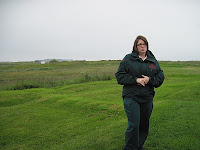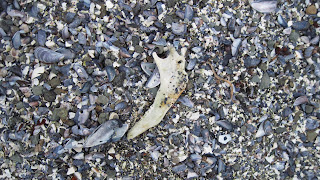 |
| The Norse Sod House at L'anse aux Meadows |
I had done some research about this place before coming all of this way, but I will admit that I didn't spend days on it. I did this deliberately, because I wanted there to be something new to discover and enjoy that process when I got there. So heading to this site, this World Heritage Site, meant being open to learning something new.
 |
| The Commemorative Sculptures of the meeting of the European and Native Cultures at L'anse aux Meadows, Newfoundland, Canada |
 |
| A reproduction of a small Norse sailing vessel |
 |
| Abigail and Nicole inside the Norse Sod House |
 |
| The Norse Blacksmithing Shop |
 |
| Close up of the Sod House Peat Wall |
 |
| Door Carvings to the Master's Sleeping Quarters |
 |
| Norse Tent looking out towards Labrador and the bay |
 |
| A boat in the process of being built from local wood with authentic tools |
 |
| The actual mounds left from the Norse Dwellings from 1,100 AD |
 The thought of humanity's journey had never really occurred to me in quite this way. I moved through the exhibits with care, reading each one and looked at the archeological evidence that the scientists discovered and verified this site's Norse authenticity. We watched a video of the discoverers, and then we headed out on the tour.
The thought of humanity's journey had never really occurred to me in quite this way. I moved through the exhibits with care, reading each one and looked at the archeological evidence that the scientists discovered and verified this site's Norse authenticity. We watched a video of the discoverers, and then we headed out on the tour.Our tour guide was born and raised in northern Newfoundland, in one of the tiny communities that hug the coast, and her stories and heavy local accent added a lot to the presentation.
We saw the mounds where the Norse dwellings were located, now covered in thick grass overlooking the cove and the ocean, along with a few rocky islands.
 |
| Close-up of the Norse Boat |
 |
| Charcoal for the Forge |
 |
| The Charcoal Pit |
 |
| Ben samples the Brewis, a local fish dish |
It looked like the Norse would have had a busy day every day to gather firewood needed for the winter, food, fishing, making tools, building the houses, keeping healthy and tanning hides... I don't think they were sitting around much! However, it was very quiet and peaceful inside the Sod House, with a deep, earthy feeling that we really enjoyed. It felt very similar to the native American Earth Lodges I have been in, and the area around their settlement was beautiful, clean and fresh
 |
| The Viking Burger |
I walked back to the Visitor's Center on my own, soaking in the area. I did not expect how deeply this meeting of the Human family, this convergence of Cultures, would affect me. I saw cloudberry plants, moose tracks on the boardwalks and I spent time with the sculptures again too. I could feel the courage and strength in the Norse travelers, in the Native voyagers who fished these waters and hunted these lands for thousands of years. These peoples faced open oceans, fierce predators and intense climates using clothing and gear they made themselves with resources from nature, and their strength was steeped in the land all around me. It wasn't just the Norse/Viking peoples, but all peoples who traveled far to rest on the shores, on the land where I now stood.
 |
| Mittens made from local craftspeople with felted wool, at the Dark Tickle. They looked very warm! |
When we all regrouped at the car, we were in the mood for food. The interpreters told us to go for the Viking Burger at The Northern Delight Restaurant in Gunner's Cove, so we had some ideas as to what to look for! When we got there, they had a nice craft shoppe and art gallery as well as the restaurant, and we got some food. Ben went for the local Newfoundland fare, called 'Brewis':
"Fish and brewis is another popular seafood dish. Brewis is hard tack, softened by cooking in pork fat along with the cod. The best part of this dish is the scrunchions, which are small, crunchy pieces of fat-back pork. They’re extremely tasty, and they make this meal. Fish and brewis can frequently be found on café and restaurant menus."
 |
| A Beautiful Scarf At the Dark Tickle |
After our meal, we found ourselves stopping at a small shop where a carver worked antler, whale bone and soapstone. He told us stories of gathering berries, finding moose antler sheds, caribou and polar bear stories and how unusual the icebergs were to still be around in the coves. We really loved hearing the stories of the local people, who were happy to share and exchange tales as we enjoyed the shops and crafts.
 |
| Heading into St Anthony |
 |
| The Icebergs of St Anthony's Bight, looking across from the town. |
 |
| Young Newfoundland Entrepreneurs! |
The coolest earrings I saw were made of arrowheads shaped from Newfoundland Chert, by Tim Rast. I am hoping to see if we can visit him when we come up again and get some lessons and hear some stories about making native arrowheads, Inuit style points, etc. His work is excellent, detailed and authentic!
We headed out again, and the sun had burst through the cloud layer and it was warming up. We went into St Anthony, to get some supplies, check email and see if we could find some fresh fish to cook for dinner. We were amazed to see more icebergs, bright and huge, crowding the bay. These were massive, twice as big as a large New England Barn, and again, we were speechless. The blue sky reflected deep blue streaks in the brilliant white ice, a color so incredible it looked fake. It was like a blue raspberry slush!
 We saw a cute roadside stand that we had to take a picture of, where three local kids were selling iceberg ice (by donation, actually!) It was awesome, and their mom and dad came down and sat with us to enjoy the warm weather and sunshine.
We saw a cute roadside stand that we had to take a picture of, where three local kids were selling iceberg ice (by donation, actually!) It was awesome, and their mom and dad came down and sat with us to enjoy the warm weather and sunshine. It was an amazing day, one of the best (I always say that, because it's true!) and our experiences were growing in leaps and bounds. Our companions were getting along well, and our food was good and there were new and unique things to see and do around every corner!
To Be Continued...
Just a note about the pictures in my blog: Evidently, if you click on one of the photos, you can see the original size of the picture, and a whole string of photos underneath, of all of the pictures in each blog entry. It is great to see them large, in detail, so check them out!





































